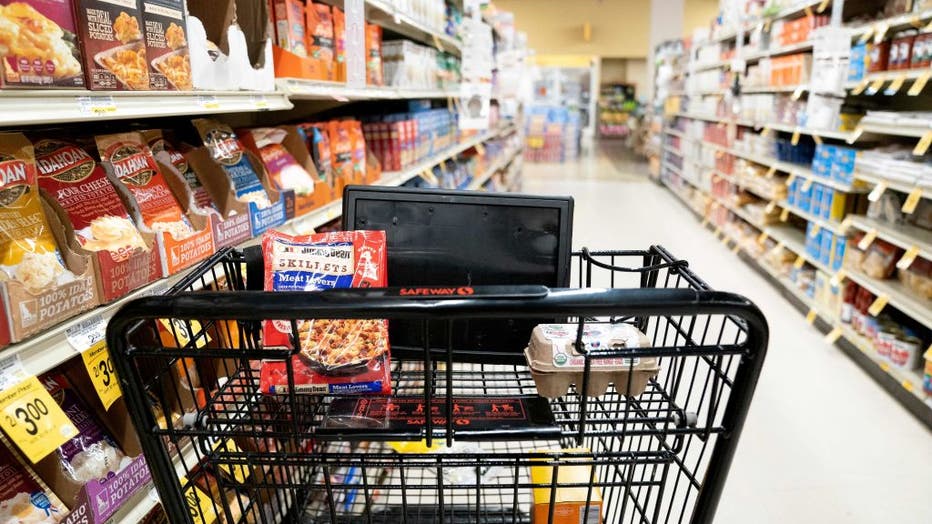Trump tariffs: Here's a list of products that will get more expensive
Tariffs expected to increase grocery prices
Trump said there would be a 10% baseline tax on imports from all countries and higher tariff rates on dozens of nations that run trade surpluses with the U.S.
LOS ANGELES - President Donald Trump on Wednesday announced new tariffs on nearly all U.S. trading partners - a 34% tax on imports from China and 20% on the European Union, among others — that triggered threats of countermeasures and urgent calls for talks to find ways to rescind the stiff new import taxes imposed on goods from countries around the globe.
Trump said there would be a 10% baseline tax on imports from all countries and higher tariff rates on dozens of nations that run trade surpluses with the U.S.
SUGGESTED COVERAGE: 'It's our turn to prosper': Trump announces 10% baseline tariffs on imports from all countries
The action kickstarts what could be a painful transition for many Americans as middle-class essentials such as housing, autos and clothing are expected to become more costly.
PREVIOUS COVERAGE: Trump tariffs: Here's what could get more expensive for Americans
The impact of Trump's tariffs
Several new tariffs are now in effect... impacting both American consumers and businesses.
Here are some of the products that will be affected.
Automobiles
Every car is about to get more expensive.
Trump's previously announced 25% tariff on auto imports is in effect. This affects any vehicle not assembled in the U.S., which accounts for 46% of the 16 million vehicles sold domestically last year, according to S&P Global Mobility reports.
SUGGESTED: Should Americans rush to buy a car before the tariffs? Here's what Trump says
Because some U.S.-made vehicles include parts imported from other countries, those vehicles will face new tariffs and increase the overall purchase price, according to experts.
Buying a car? How could Trump's tariffs impact your purchase
Starting April 2, new tariffs will go into effect for foreign made cars. What does this mean for people looking to buy a new car?
Additionally, all imported autos will face 10% universal tariffs.
Clothing and Shoes
According to a report from the American Apparael & Footwear Association, the U.S. gets 97% of its apparel and shoes from other countries.
The biggest exporters that supply U.S. stores like Target and Walmart include China, Bangladesh, and Vietnam.
All three nations will face reciprocal tariffs from the Trump administration.
Trump claimed Vietnam, one of the major apparel suppliers, charges the U.S. 90% in tariffs.
SUGGESTED: Trump tariffs could raise price of rebuilding for Eaton, Palisades fire victims
Shares in Nike, Adidas, and Puma dropped sharply Thursday after Vietnam was targeted with a 46% tariff rate, Cambodia with 49%, Bangladesh with 37% and Indonesia with 32%, while Trump hiked tariffs on China by an extra 34 percentage points, following the earlier 20% tariffs, Reuters reports.
Additionally, shares in retailer H&M, which sources mainly from China and Bangladesh, fell 5%.
Electronics and Appliances
The top exporters of electronics to the U.S. - such as TVs and iPhones - face reciprocal tariffs. This includes China, Taiwan, and South Korea.
The Trump administration plans to hit China with a reciprocal tariff of 34%, which means that products manufactured there and imported into the U.S. could see higher prices soon after the levies go into effect on April 9.

A shopper browses televisions at a Best Buy store on Black Friday in San Francisco, California, US, on Friday, Nov. 25, 2022. (Photographer: David Paul Morris/Bloomberg via Getty Images)
Meanwhile, a 32% tariff will be imposed on Japan, Korea, and Taiwan.
SUGGESTED COVERAGE: Trump floats 3rd term idea, suggests 'methods' to extend presidency
According to the Council on Foreign Relations, nearly all iPhones are still manufactured in China, although Apple has shifted some of its iPhone manufacturing to India. However, the Trump administration will also be adding a 26% reciprocal tariff to Indian imports.
China is the top exporter of smartphones, laptops, TVs, gaming consoles and all the parts that comprise them, with Beijing bringing in $146 billion worth of such imports in 2023, according to the International Trade Commission.
Experts said now is the time to buy any new electronics or appliances like washers and dryers that you've had your eye on.
Coffee and Chocolate
According to data from the U.S. Department of Agriculture, the U.S. imports about 80% of its coffee beans from Latin American countries, including Brazil and Colombia - both of which are facing 10% tariffs.
SUGGESTED COVERAGE: Justice Department investigating surge in egg prices: report
Another major Latin American import is chocolate. According to the USDA, two nations that export the majority of cocoa beans to the U.S. - Ecuador and Cote d'lvoire in West Africa - face reciprocal tariffs of 10% and 21%, respectively.
Other Food
Tariffs will further impact some other food staples such as oats. Canada is the world's largest producer and exporter of oats, with over 90% of the oats milled for food in the U.S. sourced from Canada. The grain is used in many cereals because there isn't enough domestic oats to meet the demand.

A grocery cart sits in an aisle at a grocery store in Washington, DC, on February 15, 2023 (Photo by STEFANI REYNOLDS/AFP via Getty Images)
Additionally, UK farm group The National Farmers’ Union pointed out the U.S. was the country's largest market for agri-food products outside the EU.
SUGGESTED: RFK Jr. says states can – and should – block soda from food stamps benefits
Furniture
According to data from the Home Furnishings Association, about to 30 to 40% of furniture sold in the U.S. is manufactured in other countries. The top exporters to the U.S. include China and Vietnam.
Other countries that will be affected by tariffs include Cambodia, Thailand, and the Philippines.
Lumber
Experts tell FOX 11 that the combination of demand and tariffs on imports from Canada, China and Mexico could increase the cost of building materials significantly.
Trump's proposed tariffs are aimed at countries that supply many building materials.
"People projecting numbers and the current-day price really need to, I think, shoot for 25% higher, at least, with labor and material costs going up," Reiff Anawalt of Anawalt Lumber told FOX 11.
SUGGESTED: Trump tariffs could raise price of rebuilding for Eaton, Palisades fire victims
Anawalt says he's already had questions about building costs, and says it may be similar to what the industry saw during the COVID-19 pandemic.
Tariffs could make wildfire rebuilding more expensive
Residents hoping to rebuild after the Palisades Fire and Eaton Fire may face higher costs thanks to upcoming tariffs. China, Canada and Mexico are all major U.S suppliers of lumber and drywall.
"Mexico is our drywall. Canada's our wood. Electronics and metal [are] coming from China," said Shelby Rothman with Enjoy Financial. "So there is not one thing that we produce mass here in America that's going to be going into those homes that are being rebuilt, except for our labor."
So just how much could prices rise?
"People projecting numbers and the current-day price really need to, I think, shoot for 25% higher, at least, with labor and material costs going up," Anawalt said.
Swiss Watches
Swiss imports to the U.S. will face a reciprocal tariff of 31%, which will impact watches from brands such as Swatch and Rolex.
A day after Trump's tariffs announcement, shares in European luxury companies dropped - including on goods from the EU and Switzerland, Reuters reports.
SUGGESTED: These Southern California cities are increasing sales tax rates on April 1
The European Union was targeted with a 20% rate, while Switzerland with a 31% rate.
Could tariffs make inflation worse?
New economic forecast predicts President Trump's tariffs could worsen inflation and slow growth for the U.S, Canada and Mexico. White House officials are defending the new policy, saying the US needs a reset on trade.
Wine and Spirits
Your tab at the bar post-tariffs will depend on what's in your glass.
Domestic products are expected to remain unchanged, while foreign wine and spirits will be affected.
This includes a reciprocal tariff of 20% for European Union imports (like Scottish whiskey and French and Italian wines), while United Kingdom-made products will face a 10% import duty.
SUGGESTED: Trump threatens retaliatory 200% tariff on European wine after EU proposes American whiskey tax
As an alternative, experts recommend purchasing California wines and whiskey from states in the South like Tennessee and Kentucky.
The Source: Information for this story is from previous FOX 11 reporting, Reuters, The Associated Press and FOX TV Stations.

